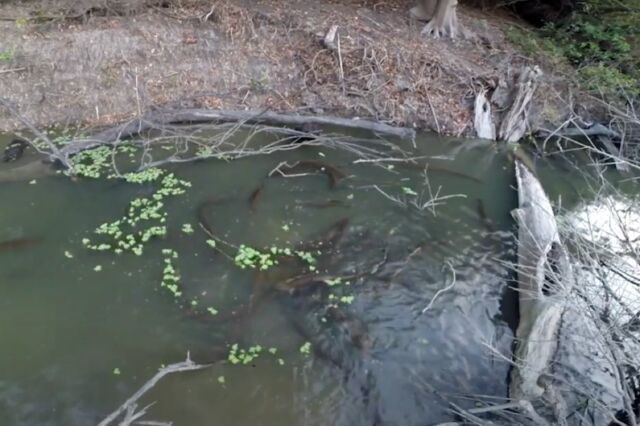Electric eels were long believed to be solitary predators, preferring to hunt and kill their prey alone by sneaking up on unsuspecting sleeping fish at night and shocking them into submission. But according to a recent paper published in the journal Ecology and Evolution, there are rare circumstances in which eels employ a social hunting strategy instead. Specifically, researchers have observed more than 100 electric eels in a small lake in the Brazilian Amazon River basin forming cooperative hunting parties to capture small fish called tetras.
"This is an extraordinary discovery," co-author C. David de Santana, of the Smithsonian National Museum of Natural History, said. "Nothing like this has ever been documented in electric eels. Hunting in groups is pretty common among mammals, but it's actually quite rare in fishes. There are only nine other species of fishes known to do this, which makes this finding really special."
Electric eels are technically knife fish. The eel produces its signature electric discharges—both low and high voltages, depending on the purpose for discharging—via three pairs of abdominal organs composed of electrocytes, located symmetrically along both sides of the eel. The brain sends a signal to the electrocytes, opening ion channels and briefly reversing the polarity. The difference in electric potential then generates a current, much like a battery with stacked plates.

This isn't the first time researchers have made surprising discoveries about electric eels. For instance, the 19th-century physicist Michael Faraday conducted several experiments with electric eels in 1838. He noted that he only felt mild shocks because the water dissipated the discharges so quickly. Vanderbilt University biologist and neuroscientist Kenneth Catania is one of the most prominent scientists studying electric eels these days. He has found that the creatures can vary the degree of voltage in their electrical discharges, using lower voltages for hunting purposes and higher voltages to stun and kill prey. Those higher voltages are also useful for tracking potential prey, akin to how bats use echolocation.
And in 2016, Catania reported evidence in support of Alexander von Humboldt's 1800 account of how Venezuelan natives at the time used wild horses to lure and trap electric eels ("horse fishing"). The stamping and snorting of horses in the shallow waters favored by electric eels caused the latter to leap up and stun the horses with a series of high-voltage electric discharges as a defense mechanism. Once the eels were exhausted, the natives could catch them easily using small harpoons on ropes.
For centuries, naturalists dismissed Humboldt's account because nobody since had noted such behavior—until Catania spotted eels in his lab reacting much like Humboldt's description to the sight of the net used to transfer the eels from their cages to the chamber Catania used for experiments. He conducted experiments with LEDs mounted on a fake alligator head (outfitted with conductive tape to visualize the discharges). The eels aggressively attacked the fake alligator head just as described by Humboldt. Catania believes the response kicks in under certain conditions, such as when eels are stranded in small bodies of water with the sudden arrival of the dry season.
Until 2019, scientists thought that the electric eel was the only species in its particular genus. That was the year de Santana published a paper effectively tripling the number of known species of electric eels. Among those was the subject of the current paper: Volta's electric eel (Electrophorus voltai).
"An individual of this species can produce a discharge of up to 860 volts, so in theory if 10 of them discharged at the same time, they could be producing up to 8,600 volts of electricity," said de Santana. "That's around the same voltage needed to power 100 light bulbs." He has been shocked several times in the field and notes that while it only lasts a fraction of a second, a shock can still cause painful muscle spasms.

De Santana and his co-authors first noticed the unusual group-hunting behavior on a 2012 field expedition to explore the diversity of fish of the Iriri River, when team member (and co-author) Douglas Bastos found a small lake packed with over 100 electric eels. A second expedition in 2014 found a similarly sized group in the same location, and the team would ultimately log some 72 hours of continuous observation, recording the eels' behavior.
Most of the time, the eels just hung out in the deeper end of the lake, occasionally surfacing to breathe. But the eels became active at dusk and dawn. De Santana's team noted how the eels would work together to herd schools of tetras into a densely packed areas in the shallow waters, by swimming in a large circle to create the equivalent of a corral. Then the eels spit into smaller hunting parties of about 10 eels, surrounding the ball of tetras and stunning the small fish with synchronized high-voltage discharges. That made it very easy to snap up the stunned tetras.
"This is the only location where this behavior has been observed, but right now we think the eels probably show up every year," said de Santana. "Our initial hypothesis is that this is a relatively rare event that occurs only in places with lots of prey and enough shelter for large numbers of adult eels." If the behavior were commonplace, he reasoned, it would have come up in their interviews with the locals.
De Santana and his team will continue their investigation of this unusual behavior; they are hoping to make direct measurements of the synchronized discharges on their next expedition. And they have a launched a citizen scientist program called Project Poraque to track down additional packs of electric eels in the region. The team will also collect eight to 10 adult eels and bring them to a lab in Germany to better study them under more controlled settings.
DOI: Ecology and Evolution, 2021. 10.1002/ece3.7121 (About DOIs).
Listing image by L. Sousa
reader comments
64